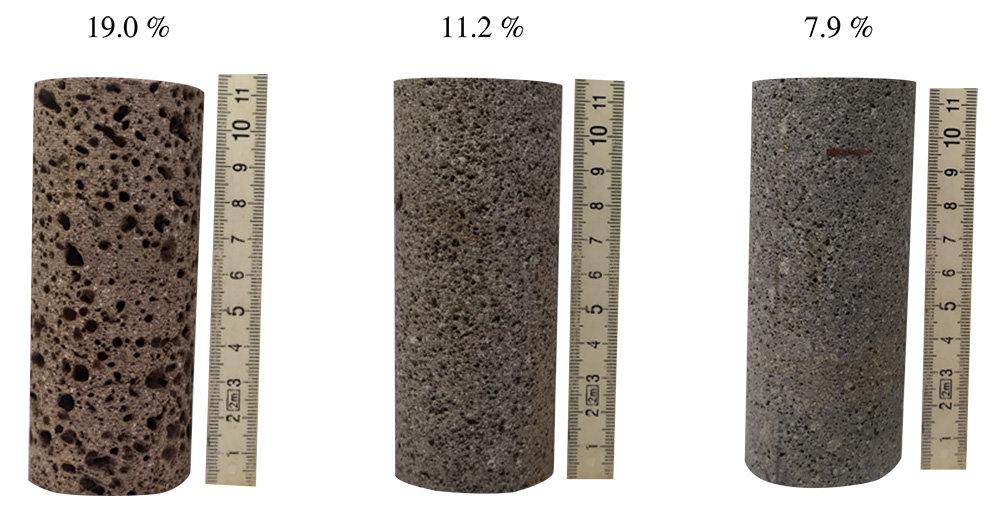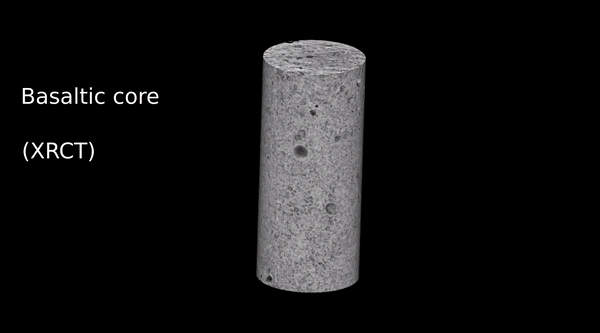#6 blog
Why flow is key for successful carbon mineralization

April 2024 - Eleni Stavropoulou
Carbon mineralization in Basalts is an efficient technology for permanent CO2 storage through mineral reaction between the hosting rock and the injected CO2. But what do we know about the interplay between mineralization and pore clogging and how can it impact storage capacity? Results from lab testing and pore network modelling have revealed the role of micro-porosity in controlling these phenomena.
Carbon mineralization in basalts is a promising cost-effective technology for permanent CO2 storage with multiple advantages compared to other storage technologies. CO2 is dissolved in water and injected at shallow depths of a few hundred metres in highly permeable locations. Basalts contain mineral compositions that are highly reactive to dissolved CO2 which is transformed and permanently stored in the form of solid carbonates (mineralization). CO2 dissolution in water prior to injection increases trapping safety, by reducing risk of leakage to the surface. Because the CO2 can be injected at shallow depths, this results in lower drilling and monitoring costs.
In 2023, the DemoUpStorage team started with the injection of Swiss CO2 at the Helguvík site of Carbfix in Iceland dissolved for the first time in seawater as opposed to fresh water. The injection is taking place at a site with highly fractured basaltic structures targeting a depth below 400 m in order to ensure large injection volumes. Evidently, injection and therefore CO2 mineralization rely on the flow properties of the basaltic formation: after injection, the CO2-rich seawater must migrate into zones of the basaltic structure that can absorb a lot of it. However, mineral precipitation can result in local pore clogging and eventual porosity reduction of the basalt rock that may threaten the storage potential.
The testing protocol has been designed in order to reproduce pressure conditions representative to the field. First, the basaltic core is flooded with brine and its intrinsic flow properties are measured with the application of a hydraulic gradient between the two sides of the sample (bottom-top). CO2-rich seawater is then injected into the core and left for several months to observe any reactions with the rock minerals. Whether mineralisation has taken place can be determined after completion of the reaction phase by means of a flow test: lower fluid flow rates signify reduced porosity and therefore areas of mineral precipitation due to injected CO2.

Figure 1: Tested basaltic cores of varying porosity (%)
The lab results showed flow reduction, and thus potential carbon mineralization, already after 2 months of CO2 injection in some of the tested cores. To identify the areas in the material where mineralization takes place, the cores were scanned with x-ray tomography (XRCT) and their pore structure before and after CO2 injection was compared.
Only slight changes of total porosity have been overall identified from the tomographic images that cannot be easily associated to the acquired flow results. This can be explained in two ways: On the one hand, the measured porosity is limited by the image resolution, i.e. pores of lower volume than the voxel size – the 3D equivalent of a pixel – of XRCT cannot be detected. On the other hand, flow depends on the connected pore space of the core rather than the total pore volume.
To understand the impact of potential carbon mineralization on the connected porosity of the material, we employed pore network modelling (PNM) to numerically simulate the performed flow tests. The real pore network of each core was reconstructed based on the pore space that was identified from the XRCT images. In addition, a micro-porosity representing the pores of the core that are not visible from x-rays was assigned. The results of flow simulations showed that micro-porosity is controlling the transport properties of the material. This means that even though no significant reduction of the large pores (visible from x-rays) may be measured, the flow rate is reduced due to volume reduction of the micro-pores. The obtained simulation results combined with image analysis of the x-ray tomographies suggest that carbon mineralization can impact the flow properties of the basaltic material, by means of reduction of micro-porosity.
Successful implementation of the technology at large scales requires injection in locations of high porosity, ideally in fractured zones where flow can be ensured, and mineralization will not result in pore clogging.
Figure 2: Pore network reconstruction and flow simulation from 3D x-ray images
The results of this study show that carbon mineralization can indeed impact the flow properties of the basaltic material. Successful implementation of the technology at large scales requires injection in locations of high porosity, ideally in fractured zones where flow can be ensured and mineralization will not result in pore clogging. The selected site of the pilot project in Helguvik meets these criteria and the measurements will show whether the carbon mineralization works as promised in the laboratory tests.
Author
Eleni Stavropoulou is a scientist in EPFL (Laboratory of Soil Mechanics) and co-leader of the lab activities in DemoUpStorage
References
Eleni Stavropoulou, Cesare Griner, Lyesse Laloui, Impact of CO2-rich seawater injection on the flow properties of basalts, International Journal of Greenhouse Gas Control, Volume 134, 2024, 104128, ISSN 1750-5836, https://doi.org/10.1016/j.ijggc.2024.104128.


